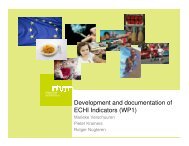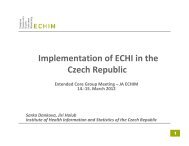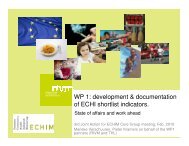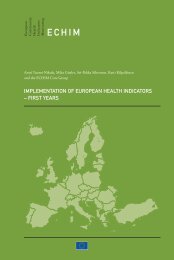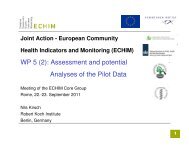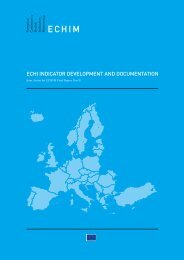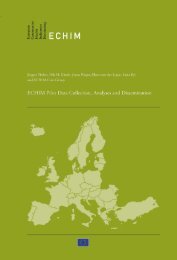INDICATORS
ECHIM Final Report
ECHIM Final Report
You also want an ePaper? Increase the reach of your titles
YUMPU automatically turns print PDFs into web optimized ePapers that Google loves.
ANNEX 4<br />
ANNEX 4: Country Specific Section<br />
In this annex the information derived from the Country Reports, the ECHIM Survey<br />
and the Bilateral Discussions is compiled by country, in order to create a general view<br />
of the participating countries, as separate entities as well as in European context. The<br />
health indicator data availability is reviewed, as well as the main data sources and health<br />
reporting. The main emphasis is, however, on the prerequisites and possibilities to<br />
implement the ECHI indicator system in the countries.<br />
The structure of the Country Specific Section is standardised for all countries. It consists<br />
of not more than two pages of text and the so-called Info Box by which the main points<br />
of the information are visualised. The countries are assorted in alphabetical order. In<br />
this introduction the structure is looked through, and the frequently used abbreviations<br />
are explained.<br />
The Country Specific Sections (abbreviation: CSS) start with the indicator data<br />
availability figures according to both the Country Report (CR) and the ECHIM Survey<br />
(ES). The figures are not outright comparable, because the indicators in the CR and the<br />
ES were not totally correspondent. For the CR, the availability figure is the percentage<br />
of the ECHI shortlist indicators for which there are data available in the international<br />
data sources, most notably Eurostat, WHO Health for All database and OECD Health<br />
Data. The fact that for many ECHI indicators there are no datasets in those databases<br />
has been taken into account by counting these indicators out of the total number of<br />
indicators that is used as denominator. Thus, as 17 of the 82 ECHI shortlist indicators<br />
(before July 2008) are missing in the data sources, the denominator and theoretic 100%<br />
score is 65. The average score of 32 countries is 68%, the highest being 86% and the<br />
lowest 35%. The score is clarified by referring to the indicator groups of particularly<br />
high or low availability figure.<br />
The data availability figures of the ES are based on the individual 52 indicators reviewed<br />
in the ES. They differ from the ECHI shortlist indicators so that the generally best<br />
available indicators, i.e. all demographic and socio-economic factors and many health<br />
services indicators were left out. Instead, some important health examination survey<br />
indicators were included, although they were not on the current ECHI shortlist. The<br />
European average score is 77%, ranging from 58% to 100%. The most important<br />
factors of the score are explained similarly as in the case of the CR, and in some cases<br />
some important data sources are also mentioned, particularly health interview surveys<br />
(abbreviation: HIS), health examination surveys (HES) and registers.<br />
The differences in data availability between the CR and the ES are not completely<br />
comparable, but by observing the availability scores some remarkable findings can be<br />
made in many cases. The most frequent observation is that often the ES availability<br />
143



